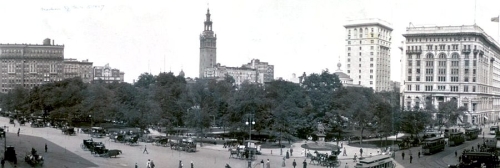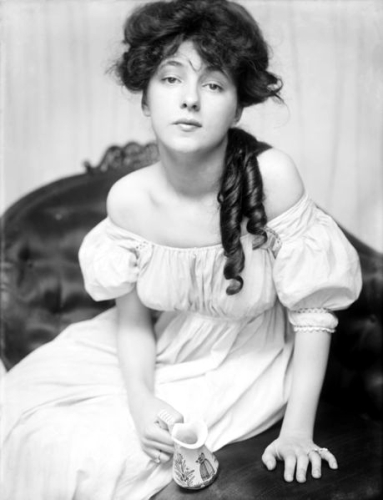Walkabout: Brooklyn’s Architects: Stanford White, Part 4
In 1906, as one of the United States’ most famous and accomplished architects, New York’s own Stanford White was at the pinnacle of his success. His firm, McKim, Mead & White, had designed some of the country’s best new buildings: Beaux-Arts visions of a shining new City Beautiful, as well as the homes of some…

In 1906, as one of the United States’ most famous and accomplished architects, New York’s own Stanford White was at the pinnacle of his success. His firm, McKim, Mead & White, had designed some of the country’s best new buildings: Beaux-Arts visions of a shining new City Beautiful, as well as the homes of some of the richest families in the country. White was from wealth himself, and was comfortable in the worlds of privilege and comfort, able to design for his clients anything they desired when it came to luxury. His homes, clubs, office buildings and public buildings, and structures, even his churches, reflect that easy familiarity with the best of life.
Here in Brooklyn, he helped turn Grand Army Plaza into the city’s largest and best example of the City Beautiful. While his partner Charles McKim designed the Brooklyn Museum, Stanford White was busy making world class entrances to Prospect Park and inspiring memorials to the country’s Revolutionary War dead in Fort Greene Park. There was also a ritzy headquarters for the Atlantic Yacht Club, on the shores of Gravesend Bay. Everything was going splendidly. But the shining life of Stanford White hid a dark side.
The charming family man, with an adoring wife and son, was a profligate sexual predator. The garrulous and affable colleague, who could sell to his clients the most opulent visions, had a not-so-secret life of debauchery with girls young enough to be his daughters. His talents of persuasion included a talent for seduction. It was to be his most damaging and disappointing personal flaw, and it would eventually get him killed.
White designed Manhattan’s Madison Square Garden in 1890. It was a large and opulent building designed for entertainment venues in Madison Square, overlooking Madison Park, at 26th Street and Madison Avenue. The Beaux-Arts-meets-Moorish-looking building had a huge main hall (which could hold 8,000 people), a separate concert hall, another large theater, the city’s largest restaurant, and a rooftop garden restaurant and theater. The building had a large tower which made it the city’s second tallest building for many years, topped with a scandalous statue of a nude Diana holding a torch aloft, sculpted by August Saint-Gaudens, one of Stanford White’s favorite sculptors, and his closest friend.
White kept a large, multi-roomed loft apartment in the tower, and was known for spending days there, obsessively working on drawings and projects for clients. He stored furnishings for his clients there too, all inspiration for his work. The family home was at Box Hill, out on Long Island, and his family was used to him staying in the city. What his wife, Bessie, didn’t know, or probably didn’t want to know, was that Stanford also used the apartment for his many assignations and affairs.
Stanny liked young girls — the younger and more virginal and innocent, the better. New York was full of them: desperately poor girls who came to the city to make a living as artists’ models, chorus girls and actresses in low-budget theatrical productions. Many had mothers who accompanied them for modesty’s sake, keeping them from prostitution, and hoping their daughters would meet nice rich young men who would marry them and take them away from the hard lives they had had. It was an age-old fantasy, and every once in a while, it would come true, bringing even more girls to the city.
This was the fervent hope for Evelyn Nesbitt of Pittsburg. Her family had been pretty well off until her father’s death, when she was a child. His debts wiped out the family finances, and they went from comfort to utter poverty. She and her mother and brother had often gone hungry, as her mother could not find work, and the family moved from one cheap location to another in Pennsylvania. Evelyn was a beautiful young girl, and became an artists’ model at fourteen, working with many artists in Philadelphia.
At fifteen, and the breadwinner of the house, she told her family they were moving to New York so she could pursue her career. She soon became a successful model here, with her face appearing in ads and illustrations. She then discovered that being a photographers’ model was more lucrative, and could lead to a theater job, so she dropped the artists, and became a photographers’ fashion model, appearing in the fashion pages of New York newspapers. Soon afterward, her dream was realized, as theater offers came in, and she became a chorus girl in Florodora, the theater world’s most famous chorus line and musical review.
For chorus girls, being in Florodora was like being a supermodel. The girls were all young and beautiful, and on display for the wealthy men who flocked to the show. They were wined and dined and received lavish presents; many affairs and even a few marriages took place. It also paid more than anything the Nesbitt family had seen in a long time. Mrs. Nesbitt’s initial displeasure with her daughter’s career choices was soon quieted. It was on the stage of Florodora that Stanford White first saw the sixteen-year-old Evelyn. He was smitten, and he wanted her.
He invited her to lunch at his apartments in the Garden, showing her rooms filled with opulent furnishings, Oriental rugs, and the treasures of the world that he had gathered for himself and clients. One of those rooms had a red velvet swing hanging from the ceiling, and after invited to try it, Evelyn soared over Stanny’s head until she was dizzy, using her heels to puncture a paper umbrella he waved at her as she passed above him. He gave her a sumptuous lunch, and wooed her, telling her that he could buy her things and help her career. He gave her his dentist’s contact information, telling her he would pay to have her bad teeth fixed, so she could get better theater jobs, and then he sent her home.
Sixteen year old Evelyn was smitten by the charming and generous man. She raved to her mother about the apartment and how nice Mr. White was, and how interested he was in helping her. She went back to Stanny’s apartment for lunch again, and again had a great time. Her mother had balked at sending her to the dentist, but after meeting Stanford White in his office, she was satisfied that his intentions were honorable, and she allowed her daughter to get her teeth fixed, and see Mr. White again.
A week after getting her teeth fixed, the Nesbitts moved from their modest rooms to an apartment in the posh Audubon Hotel. Stanford White arranged for Evelyn’s younger brother to be sent to a private military academy outside of Philadelphia. When Mrs. Nesbitt went out of town soon afterward, she had no problem leaving her daughter in the care of Mr. White, who promised to look after her as one of his own.
As you can imagine, that didn’t happen. According to Evelyn Nesbitt’s story, Stanny took her out one night for an evening of dinner and much champagne. They went back to his apartments, where they continued to drink. He asked her to change into a yellow silk kimono, they drank some more, and she passed out on a magnificent bed surrounded by mirrors. When she awoke, she was no longer a virgin. White kissed her, and told her she was his, and promised to take care of her.
Throughout her life, she changed the story about whether she enjoyed being his mistress or was ashamed and degraded; whether she loved or hated him, but she was a sixteen-year-old girl under the thrall of a middle-aged man of power and influence. She was not the first girl he had been obsessed with, and would not be the last.
While Stanford White’s indiscretions were well-known to his friends and acquaintances in high society, no one seemed to take him to task for it. In a society that prided itself for being far above the base and low-class desires and scrabblings of the common man, White’s appetites seemed to have no consequences. He was still accepted into society; in fact, he was welcomed wherever he went. The only person who seemed to loathe and hate him was one Harry Thaw of Pittsburgh.
Perhaps it was because they had quite a bit in common, including a penchant for chorus girls. Only the much older and much more accomplished Stanford White was a much better seducer. The thought of that just killed Harry Thaw, so he decided that one day, he’d have to return the favor to Stanford White. When he married Evelyn Nesbitt, and learned of the affair, the deed would be done.
Who was Harry Thaw, and what happened after that fateful night at Madison Square Garden? We’ll end the story of Stanford White next time.
Photograph of Madison Park, with Stanford White’s Madison Square Garden in the center, Wikipedia.
Walkabout: Stanford White, part 1
Walkabout: Stanford White, part 2
Walkabout: Stanford White, Part 3






What's Your Take? Leave a Comment